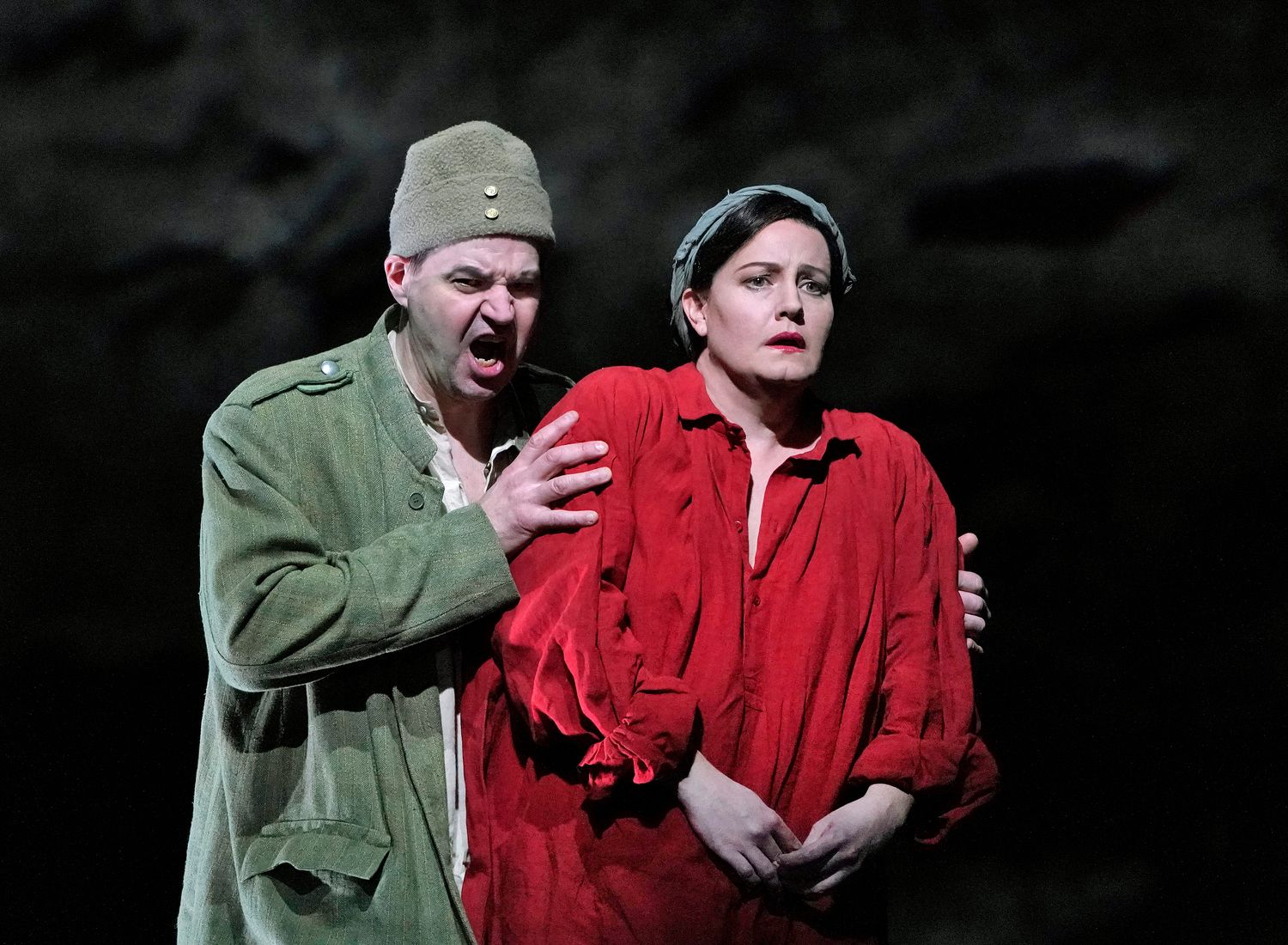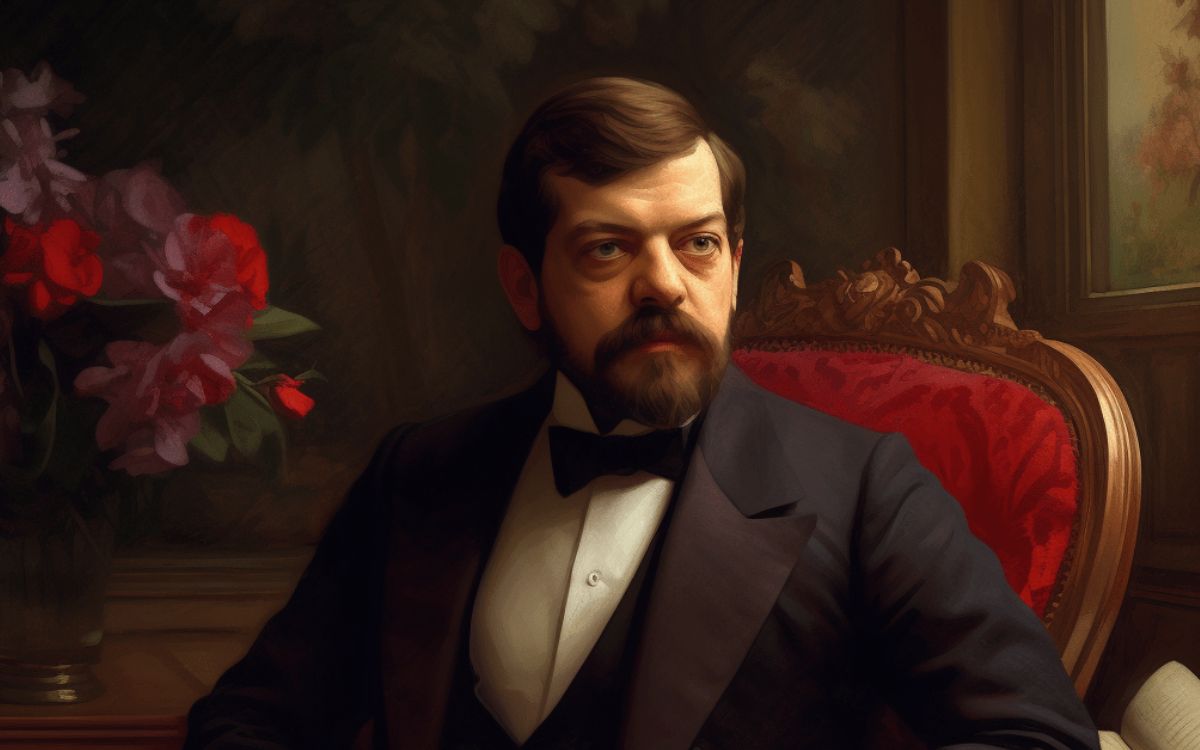Home>Events & Info>Opera>Which Term Best Describes The Style Of The Opera Wozzeck?


Opera
Which Term Best Describes The Style Of The Opera Wozzeck?
Published: January 7, 2024
Discover the style of the opera Wozzeck and explore the diverse elements that make it a truly unique and captivating opera experience.
(Many of the links in this article redirect to a specific reviewed product. Your purchase of these products through affiliate links helps to generate commission for AudioLover.com, at no extra cost. Learn more)
Table of Contents
Introduction
Welcome to the fascinating world of opera, where dramatic storytelling is brought to life through a magnificent combination of music, singing, and theatricality. In this article, we will explore the stylistic elements of the renowned opera “Wozzeck” and delve into its captivating themes and musical intricacies.
“Wozzeck,” composed by Alban Berg and premiered in 1925, is a ground-breaking work that pushed the boundaries of traditional operatic conventions. It is based on the play “Woyzeck” by Georg Büchner and tells the poignant and tragic story of a troubled soldier, Franz Wozzeck, who struggles to maintain his sanity in a society plagued by societal injustices and personal torment.
As we embark on this journey, we will unravel the unique style of “Wozzeck” and explore the elements that define it. From its expressionistic nature to its psychological realism and social commentary, this opera offers a compelling and thought-provoking experience that continues to captivate audiences today.
Join us as we dive into the world of “Wozzeck” to discover the power and beauty of this remarkable opera.
Brief Overview of the Opera “Wozzeck”
“Wozzeck” is a groundbreaking opera composed by Alban Berg, based on the play “Woyzeck” by Georg Büchner. Premiered in 1925, it is a dark and riveting tale that explores the tragic descent of Franz Wozzeck, a low-ranking soldier, into madness and desperation.
The opera is set in a gritty and oppressive environment, reflecting the societal struggles and inequalities of the time. Wozzeck, a troubled and vulnerable man, is subjected to the cruelty and exploitation of those around him. He becomes a pawn in the hands of his commanding officer and is tormented by his troubled relationship with Marie, the mother of his child.
Throughout the opera, the audience witnesses Wozzeck’s gradual deterioration, both mentally and emotionally. His fragmented mind, symbolized through the episodic structure of the opera, mirrors the disarray and chaos of his life. As the story unfolds, Wozzeck is haunted by his own inner demons and haunted by the constant presence of societal pressures and expectations.
The opera explores complex themes such as poverty, class divisions, and the dehumanization of individuals in a rigidly hierarchical society. It serves as a searing critique of the oppressive systems that crush the spirits of those at the margins.
Despite its bleak subject matter, “Wozzeck” is a masterful work of art that captivates audiences with its emotional intensity and raw power. The music, composed in a modernist style, is rich in dissonance and tonal complexity, mirroring the inner turmoil of the characters on stage. Berg’s innovative use of atonality and striking harmonic language sets the opera apart from the traditional operatic canon, making it a truly groundbreaking and influential work.
With its deeply psychological exploration of the human condition, “Wozzeck” continues to be celebrated as one of the greatest operas of the 20th century. Its tragic tale of one man’s struggle against societal forces serves as a timeless reminder of the injustices and hardships that still plague our world today.
Defining the Style of “Wozzeck”
In order to understand the unique style of “Wozzeck,” it is important to recognize its classification within the broader realm of opera. While it is difficult to categorize the opera under a specific genre, it is often identified as an example of expressionist opera.
Expressionism, as an artistic movement, emerged in the early 20th century as a response to the increasing industrialization and societal upheavals of the time. It aimed to convey the raw emotions and inner experiences of the human psyche, often through distorted and exaggerated forms.
Similarly, “Wozzeck” embodies the principles of expressionism in its approach to storytelling and presentation. The opera delves into the depths of the human condition, exploring the inner world of its characters and their struggles against oppressive forces.
The style of “Wozzeck” can be characterized by its fragmented structure and episodic nature. The opera consists of a series of disjointed scenes that reflect the fragmented mind of the protagonist, Franz Wozzeck. This fragmented structure contributes to the sense of disorientation and instability, allowing the audience to experience the chaos and inner turmoil that Wozzeck himself experiences.
Furthermore, the music of “Wozzeck” reflects the expressionist style through its use of dissonance, atonality, and unusual harmonies. Composer Alban Berg employed innovative techniques to capture the emotional intensity and psychological struggles of the characters. The music resonates with the inner angst and turmoil of Wozzeck, creating a sonic landscape that mirrors the distorted realities of his life.
In addition to expressionism, “Wozzeck” also exhibits elements of psychological realism. The opera portrays the inner thoughts, emotions, and psychological states of the characters in a highly detailed and introspective manner. This psychological depth allows the audience to empathize with the struggles and vulnerabilities of the characters, creating a powerful and immersive experience.
By combining expressionistic elements with psychological realism, “Wozzeck” presents a unique and deeply introspective exploration of the human condition. It challenges traditional operatic norms and offers a raw and unfiltered portrayal of societal injustices, mental anguish, and the complexities of the human psyche. Through its distinctive style, “Wozzeck” continues to captivate audiences and provoke thought and discussion long after its premiere.
Elements of Expressionism in the Opera
The opera “Wozzeck” is a prime example of expressionism, a movement that sought to depict the raw and intense emotions of the human experience. Here are some key elements of expressionism that are evident in the opera:
Emotional Intensity: Expressionist art aims to evoke deep emotions and create a heightened sense of the human experience. “Wozzeck” achieves this through its intense and emotionally charged music and dramatic storytelling. The opera explores themes of love, jealousy, despair, and madness, exposing the raw emotions of its characters in a visceral and compelling way.
Distorted and Exaggerated Forms: Expressionism often employs distorted and exaggerated forms to convey the subjective experiences and inner turmoil of its characters. In “Wozzeck,” this is evident in both the music and the staging. The dissonant harmonies and unconventional orchestrations create a sense of unease and discord, while the fragmented and episodic structure reflects the fragmented mind of the protagonist, Franz Wozzeck.
Social Critique: Expressionist art frequently critiques societal norms and challenges conventional beliefs. “Wozzeck” is no exception, as it shines a harsh and unrelenting light on the injustices and societal pressures faced by its characters. The opera exposes the brutal exploitation of the working class, the dehumanizing effects of poverty, and the psychological effects of societal constraints.
Surreal and Symbolic Imagery: Expressionism often employs surreal and symbolic imagery to convey deeper meanings. In “Wozzeck,” the symbolic use of the moon and the sea, for example, represents the larger forces of fate that shape the protagonist’s life. The surreal and nightmarish scenes, such as the hallucinations experienced by Wozzeck, further emphasize the distorted reality in which the characters exist.
Introspection and Psychological Depth: Expressionist art delves into the psychology and emotions of its characters, offering a deep and introspective exploration of the human condition. “Wozzeck” achieves this through its emphasis on the inner thoughts, desires, and fears of the characters. The opera invites the audience to delve into the complex and often conflicting emotions of its characters, creating a profound sense of empathy and connection.
These elements of expressionism converge in “Wozzeck” to create a powerful and unsettling experience for the audience. The opera serves as a critique of societal injustices while delving into the profound depths of the human psyche. It challenges traditional operatic norms and continues to provoke thought and introspection, making “Wozzeck” a truly extraordinary expressionist work.
Psychological Realism in “Wozzeck”
One of the defining aspects of “Wozzeck” is its psychological realism, which offers a deep and introspective exploration of the human psyche. Through the portrayal of complex characters and their inner struggles, the opera delves into the depths of the human mind, inviting audiences to reflect on the complexities of the human condition.
“Wozzeck” presents its characters in a highly detailed and psychologically nuanced manner. Protagonist Franz Wozzeck is portrayed as a vulnerable and tormented individual, driven to the brink of madness by the oppressive forces of society. The audience witnesses his deteriorating mental state and the psychological battles he wages within himself.
The opera explores themes such as identity, alienation, and the effects of societal pressures on mental health. Wozzeck’s struggle to maintain his sanity in the face of societal injustice and personal turmoil serves as a poignant representation of the universal human experience of wrestling with inner demons.
Through the music and libretto, “Wozzeck” delves deep into the characters’ thoughts, emotions, and psychological states. Composer Alban Berg brilliantly captures the emotional spectrum of the characters through his innovative use of musical language, reflecting their internal struggles and turmoil.
The portrayal of Marie, Wozzeck’s lover, is also a testament to the psychological realism in the opera. Her conflict between her love for Wozzeck and her attraction to the Drum Major highlights the complex nature of human desires and emotions. The opera exposes the psychological consequences of these conflicting emotions, ultimately leading to devastating consequences.
Furthermore, the opera delves into the psychological effects of societal structures and hierarchies. Wozzeck’s lowly position in society and his experiences as a soldier contribute to his sense of alienation and diminished self-worth. The audience is confronted with the psychological toll of living in an oppressive society and the devastating impact it can have on an individual’s mental well-being.
By portraying the intricacies of the human mind with such depth and nuance, “Wozzeck” offers a profound and empathetic exploration of psychological realism. It goes beyond surface-level characterizations and delves into the inner thoughts, fears, and desires of its characters. This psychological depth resonates with audiences, fostering a deep connection and understanding of the complexities of the human condition.
Through its psychological realism, “Wozzeck” forces us to confront the universal struggles of the human mind and highlights the importance of empathy and compassion in a world plagued by societal pressures and internal battles.
Social Commentary in the Opera
Beyond its psychological exploration, “Wozzeck” offers a searing social commentary on the injustices and inequalities prevalent in society. The opera serves as a powerful critique of the oppressive systems and societal norms that dehumanize individuals and perpetuate cycles of suffering.
One of the central themes explored in “Wozzeck” is the impact of poverty and class divisions on the lives of its characters. Franz Wozzeck, a low-ranking soldier, is trapped in a cycle of poverty, where he must undergo medical experiments as a means to supplement his meager income. The opera highlights the dehumanization of the working class and the desperate measures individuals are forced to take in order to survive.
Furthermore, “Wozzeck” explores the impact of societal pressures on individual mental health. The constant scrutiny and expectations placed on Wozzeck by his superiors and society at large contribute to his deteriorating mental state. The opera challenges the notion that mental illness is purely an individual problem, instead drawing attention to the external factors that contribute to mental instability.
The character of the Doctor in “Wozzeck” represents the dehumanizing effects of scientific objectivity and experimentation. The Doctor’s dispassionate and detached approach to Wozzeck’s mental health highlights the ways in which individuals can be reduced to mere subjects of study without regard for their well-being.
Additionally, “Wozzeck” confronts the issue of gender inequality through the character of Marie, who faces judgment and condemnation for her relationships outside of her relationship with Wozzeck. The opera exposes the double standards imposed upon women and the societal constraints that limit their agency and freedom.
The social critique in “Wozzeck” is further reinforced by the oppressive and restrictive nature of the military institution. The dehumanizing effects of the military hierarchy are laid bare, as Wozzeck becomes a pawn in the hands of his commanding officer. The opera sheds light on the abuse of power and the ways in which hierarchies can exploit and manipulate those at the bottom.
Through its social commentary, “Wozzeck” challenges the audience to question the societal structures that perpetuate injustice and inequality. It forces us to confront uncomfortable truths and examine our own roles in upholding or dismantling oppressive systems.
By shining a light on the struggles faced by its characters, “Wozzeck” urges us to strive for a more compassionate and equitable society, where the dignity and well-being of every individual are truly valued and respected.
Notable Musical Features in “Wozzeck”
The opera “Wozzeck” by Alban Berg is renowned for its innovative and influential musical composition. Its avant-garde style and use of various techniques make it a groundbreaking work in the realm of opera. Here are some notable musical features that contribute to the distinctiveness and impact of “Wozzeck”:
Atonality: One of the most striking aspects of “Wozzeck” is its departure from traditional tonal harmony. Berg’s use of atonality, or the absence of a tonal center, creates a dissonant and unsettling musical landscape. The absence of clear tonal resolutions mirrors the internal chaos and fragmentation experienced by the characters.
Expressionistic Orchestration: The orchestration in “Wozzeck” is meticulously crafted to evoke intense emotions and create vivid soundscapes. Berg skillfully employs a wide array of instruments, including unusual combinations and extended techniques. The orchestral colors range from sweeping and lush passages to stark and jarring moments, reflecting the emotional intensity and dramatic tension of the opera.
Sprechgesang: Another significant musical feature in “Wozzeck” is the use of sprechgesang, a vocal technique that lies between singing and spoken dialogue. This innovative approach to vocal performance adds a raw and gritty quality to the music, conveying the characters’ emotional struggles and enhancing the dramatic impact of their words.
Leitmotifs: Berg employs leitmotifs, recurring musical themes associated with specific characters, ideas, or emotions. These motifs help to establish continuity and provide structural cohesion throughout the opera. Each character and important element in the story is assigned a distinct leitmotif, enabling the audience to follow and connect with the narrative on a deeper level.
Musical Symbolism: The music in “Wozzeck” is rich in symbolic meaning, enhancing the storytelling and adding layers of interpretation. Berg uses musical gestures and motifs to represent the psychological states and inner turmoil of the characters. For example, the use of high, piercing notes may signify anxiety or distress, while the repetitive rhythmic patterns may symbolize monotony or oppression.
Innovative Form: “Wozzeck” features a fragmented and episodic structure, using diverse musical forms and styles to depict the fragmented mind of the protagonist. The opera consists of a series of short scenes, each with its own distinct musical character, allowing the audience to experience the disjointed and disorienting nature of Wozzeck’s reality.
These musical features collectively contribute to the power and impact of “Wozzeck.” Berg’s innovative use of atonality, expressionistic orchestration, and unique vocal techniques create a musical language that elevates and supports the emotional intensity and dramatic depth of the opera. It is through these musical innovations that “Wozzeck” continues to captivate audiences and leave a lasting impression on the world of opera.
Comparison to Other Operatic Styles
“Wozzeck” stands apart from traditional operatic styles and is often regarded as a departure from the conventional norms of the genre. Let’s compare “Wozzeck” to two other operatic styles in terms of its music and themes:
Bel canto: Bel canto, meaning “beautiful singing” in Italian, is an operatic style known for its lyrical melodies, virtuosic vocal lines, and emphasis on vocal beauty. Compared to bel canto operas, “Wozzeck” diverges significantly in its musical language and approach. While bel canto operas prioritize vocal showcase and melodic beauty, “Wozzeck” prioritizes expression and emotional intensity. The music in “Wozzeck” is characterized by atonality, dissonance, and fragmented melodies, creating a stark contrast to the melodious and refined nature of bel canto.
In terms of themes, bel canto operas often revolve around romantic love, heroic stories, or historical events. “Wozzeck,” on the other hand, delves into the dark corners of the human psyche and casts a critical eye on societal injustices and the human condition. It challenges traditional operatic narratives and offers a more introspective and gritty exploration of complex psychological and social themes.
Verismo: Verismo, an operatic style popularized in the late 19th century, focuses on realistic portrayals of everyday life and emotions. It seeks to depict raw human experiences in a naturalistic manner. While both “Wozzeck” and verismo operas embrace elements of realism, they differ in their musical and thematic execution.
Verismo operas often feature lush and melodic music that aims to capture the emotional highs and lows of the characters. In contrast, “Wozzeck” employs a more dissonant and fragmented musical language to convey the inner turmoil and psychological struggles of its characters. The music in “Wozzeck” reflects the expressionistic and atonal style of its era, diverging from the more melodic and tonal language of verismo operas.
Thematically, verismo operas tend to focus on passionate love affairs, crime, and social dramas. While “Wozzeck” examines social injustices and psychological realism, its themes are often darker and more abstract. It delves into the existential crises faced by its characters and challenges societal norms and expectations.
Overall, “Wozzeck” stands in contrast to bel canto and verismo operatic styles. Its experimental and expressionistic musical language, along with its psychological and socially critical themes, push the boundaries of traditional opera and offer a unique and thought-provoking experience to audiences.
Conclusion
“Wozzeck” is a groundbreaking opera that defies traditional categorizations and captivates audiences with its distinctive style and powerful storytelling. Through its expressionistic elements, psychological realism, social commentary, notable musical features, and departure from other operatic styles, “Wozzeck” has established itself as a work of profound artistry and cultural significance.
The opera’s expressionistic nature immerses audiences in a world of raw emotions, distorted forms, and intense subjectivity. It pushes boundaries, challenging traditional operatic conventions, and delves deep into the human psyche, offering a thought-provoking exploration of the complexities of the human condition.
At the heart of “Wozzeck” lies its psychological realism, which allows us to empathize with the struggles and vulnerabilities of its characters. By portraying their inner thoughts, emotions, and psychological states, the opera invites introspection and sheds light on the universal nature of human struggles.
Furthermore, “Wozzeck” serves as a powerful social commentary, addressing the injustices and inequalities deeply rooted in society. It critiques oppressive systems, societal norms, and the dehumanization of individuals, shedding light on the struggles faced by those at the margins.
The opera’s notable musical features, such as its atonality, expressionistic orchestration, and unique vocal techniques, contribute to its distinctiveness and amplify the emotional impact of the storytelling. The music adds another layer of depth and complexity to the opera, reflecting the inner worlds of the characters and enhancing the overall experience.
In comparison to other operatic styles, “Wozzeck” stands out for its departure from bel canto’s melodic beauty and verismo’s realism, choosing instead to explore the darker and more abstract facets of the human experience.
In conclusion, “Wozzeck” continues to hold its place as a remarkable opera that pushes artistic boundaries, challenges societal norms, and provokes introspection. Its expressionistic elements, psychological realism, social commentary, and notable musical features combine to create a masterpiece that remains relevant and thought-provoking to this day. “Wozzeck” is an enduring testament to the power of opera as an art form to illuminate the human condition and inspire reflection on the world we live in.











